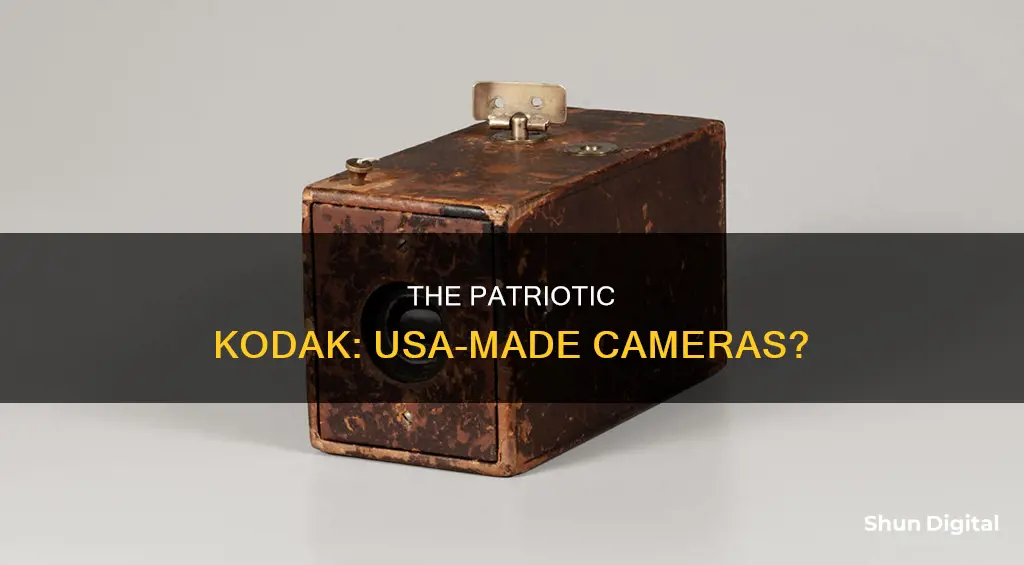
The Eastman Kodak Company, commonly known as Kodak, is an American company that produces a range of products related to film photography. The company was founded in 1881 as a partnership between George Eastman and Henry A. Strong, initially selling dry plates for cameras. In 1888, the Kodak camera was patented by Eastman, and the company was incorporated in 1892. Kodak is headquartered in Rochester, New York, and is well-known for its photographic film products, which it brought to the mass market.
While Kodak cameras have been manufactured and sold in the USA, the company has also had manufacturing facilities in other countries, including China, Germany, and the United Kingdom. Kodak's European subsidiaries continued to operate during World War II, and the company's products and technologies have been used in various government and military projects over the years.
| Characteristics | Values |
|---|---|
| Headquarters | Rochester, New York |
| Incorporation | New Jersey |
| Founder | George Eastman |
| Current CEO | Jeffrey J. Clarke |
| Initial Business | Photographic film products |
| Current Business | Imaging for business |
| Current Business Segments | Traditional Print, Digital Print, Advanced Material & Chemicals, Brand |
| First Camera | Kodak #1 camera in 1888 |
| First Camera Features | 100-exposure roll of film, simple box camera |
| Marketing Strategy | Simplifying the apparatus and processing the film for the consumer |
| Marketing Slogan | "You press the button, we do the rest" |
What You'll Learn

History of Kodak cameras
The history of Kodak cameras begins with George Eastman, a young hobbyist photographer and school dropout who became one of the first to successfully manufacture dry plates commercially in the US. In 1880, he entered a partnership with Henry Strong, forming the Eastman Dry Plate Company.
In 1888, Eastman invented and marketed the first Kodak camera, a simple handheld box camera containing a 100-exposure roll of film. The camera was sold for $25 with the film sealed inside. After the last negative was exposed, consumers sent the entire camera to one of the Eastman factories in Rochester, New York, or Harrow, Middlesex, England, where the roll was processed and printed. Eastman's slogan, "You press the button, we do the rest", summed up the ease of his new system.
The Kodak camera was made possible by technical advances in the development of roll film and small, fixed-focus cameras, but it was Eastman's marketing strategy that was his real genius. By simplifying the apparatus and processing the film for the consumer, he made photography accessible to millions of casual amateurs. Within a few years of the Kodak's introduction, snapshot photography became a national craze.
In 1889, the paper film was replaced by film on a transparent plastic base of nitrocellulose. Eastman reorganized his business as the Eastman Kodak Company in 1892. In 1900, he introduced the Brownie, a simple $1 box camera featuring a removable film container. By 1927, Eastman Kodak had a virtual monopoly of the photographic industry in the US, and it was one of the largest American companies in its field until the advent of digital photography in the late 20th century.
In 1935, the company released Kodachrome, which was an instant mass-market success. In 1969, Kodak produced the camera used by astronauts of the Apollo 11 mission, which was used on the surface of the moon. In 1975, Kodak employee Steven Sasson developed the first handheld digital camera. However, despite essentially inventing the digital camera, the company didn't focus enough on digital photography and was rapidly overtaken by other brands.
Droid Turbo: Accessing Camera Shooting Modes
You may want to see also

Kodak's marketing strategy
Kodaks Marketing Strategy
One key element of Kodak's marketing strategy is entrepreneurial marketing, which involves creating new startup businesses under the Kodak brand. For example, Kodakit, a platform that connects brands with photographers for shoots, is run as a separate startup wholly owned by Kodak. This allows Kodak to leverage its brand recognition and marketing muscle to create new businesses and expand into new categories.
Another aspect of Kodak's marketing strategy is cool collaborations with fashion brands and young, emerging photographers. By partnering with fashion brands like Opening Ceremony and Forever 21, Kodak has been able to tap into new audiences and increase its relevance, especially among younger generations. Collaborating with emerging photographers like Rosie Matheson and Krissy Saleh also helps Kodak stay connected with modern culture and creative communities.
In addition, Kodak has been leveraging its vintage brand assets to enter the streetwear market, with collections inspired by its Nascar sponsorship and Super 8 film camera. This strategy has been successful, with significant sell-through of these products, and has allowed Kodak to "piggyback" on the trend for streetwear brands.
Kodak has also focused on owned and earned media as a core part of its strategy, due to limitations in what it can do through bought media. For the Forever 21 launch, Kodak gave the collection to five photographic influencers, along with Kodak film and an instant print camera, to shoot their own campaign. This influencer campaign generated an estimated $5.8 million in reach, demonstrating the power of owned and earned media.
Overall, Kodak's marketing strategy aims to bring the consumer brand back to its former glory by leveraging vintage assets, collaborating with cool brands and creators, and creating new businesses under the Kodak name. By doing so, Kodak hopes to tap into the new nostalgia trend and reconnect with consumers, especially those with a passion for modern nostalgia and instant print photography.
Avoid Congestion Charges: Know Your Camera Blindspots
You may want to see also

Kodak's current camera models
Kodak offers a wide range of camera models, catering to both beginners and professionals. Here is an overview of some of Kodak's current camera models:
Digital Cameras
The KODAK PIXPRO series offers a range of digital cameras with varying features and specifications. Here are some models:
- AZ255: Features 16 megapixels, 25X optical zoom, and a wide-angle lens, making it perfect for aspiring photographers.
- AZ405: Delivers crisp 16-megapixel images with a 40x ultra-long zoom lens and optical image stabilisation. It also captures 180-degree panoramas and HD videos.
- AZ425: This model offers a 42x ultra-long zoom lens and optical image stabilisation for clear 20-megapixel images and HD videos.
- AZ528: The AZ528 Astro Zoom camera provides 52x optical zoom and exceptional detail, making it ideal for those seeking a balance of quality and affordability.
- AZ652: The AZ652 Astro Zoom bridge camera is a powerful option with 65x optical zoom and other impressive features.
- AZ901: Kodak's most powerful Astro Zoom camera boasts a mind-blowing 90X optical zoom, taking your photography to the next level.
- FZ45: Compact and intuitive, the FZ45 is a perfect starter camera for everyday use, featuring easy controls and a convenient design.
- FZ55: This model offers a slim, point-and-shoot design with a rechargeable lithium-ion battery, making it a step up from the FZ45.
- SP360 4K: Designed to elevate your creativity, the SP360 4K provides 4K resolution for detailed, clear, and precise images and videos.
- WPZ2: The WPZ2 is your adventure-ready companion, featuring a shockproof and dustproof design. It can be used in, on, and under the water up to 15 meters, making it perfect for capturing your aquatic exploits.
Film Cameras
Kodak also offers a range of film cameras, including:
- M35: A reusable 35mm film camera with a fixed-focus lens, manual film winding and rewinding, and a flash that can be turned on or off.
- EKTAR H35: This half-frame film camera yields double the photos for half the cost, making it perfect for beginners or those looking to experiment with film photography.
- M38: Similar to the M35, the M38 is a reusable 35mm film camera with a fixed-focus lens, manual film controls, and a switchable flash.
- S-88: A simple and user-friendly film camera designed for casual photography, perfect for those who want to capture memories without the complexity of digital cameras.
- Ultra F9: A 35mm film camera with a built-in flash, offering a straightforward and classic photography experience.
- I60: Featuring a fixed-focus lens, manual film winding and rewinding, and a built-in pop-up flash, the i60 uses 135mm film and provides a traditional photography experience.
These are just a few examples of Kodak's current camera models, showcasing their diverse range of options for both digital and film photography enthusiasts.
Samsung S7 Edge: Exploring the Macro Camera Mode
You may want to see also

Kodak's camera technology
Kodak is an American company that has been at the forefront of photography technology since its inception in the late 19th century. The company was founded by George Eastman and Henry A. Strong in 1880, initially as the Eastman Dry Plate Company, which sold dry plates for cameras. However, Eastman's vision was to replace glass plates with a new roll film process, and in 1884, the company was renamed the Eastman Dry Plate and Film Company.
The following year, Eastman patented the first practical film roll holder, allowing dry plate cameras to store multiple exposures simultaneously. He also patented a form of paper film called "American film". In 1888, the Kodak camera was patented—a box camera with a fixed-focus lens, no viewfinder, and a rotating key to advance the film. This camera was pre-loaded with a film roll of 100 exposures and could be mailed to company headquarters for processing.
Kodak continued to innovate in the 20th century, producing some of the most popular camera models of the time, including the Brownie and Instamatic. The company also developed the first self-contained digital camera. Today, Kodak offers a range of digital cameras under the PIXPRO brand, such as the AZ255, which is marketed as a "bridge camera" with 16 megapixels and 25X optical zoom.
In addition to cameras, Kodak has also diversified its product line to include digital picture frames, instant print cameras, and digital printers. The company has struggled financially in recent decades due to competition and the transition to digital photography but continues to be a well-known brand in the photography industry.
Spare Camera Battery: Safe and Easy Transport Tips
You may want to see also

Kodak's impact on photography
Kodak continued to grow and innovate throughout the early 20th century, becoming one of the world's largest film and camera manufacturers. The company developed a close relationship with the city of Rochester, New York, where it was headquartered, and was at the forefront of welfare capitalism, offering its employees various benefits and compensation. During this period, Kodak also produced some of the most popular camera models of the time, including the Brownie and Instamatic. The company's tagline, "Kodak moment," entered the common lexicon to describe a memorable personal event.
In the 1930s, Kodak introduced Kodachrome, the first commercially successful amateur color film, and in 1942, it announced Kodacolor, the world's first true color negative film for still photography. The company continued to expand and diversify its business, entering into partnerships with other companies and supplying film to the emerging motion picture industry.
However, in the late 1990s, Kodak began to struggle financially due to increasing competition and the transition from film to digital photography. Despite developing the first self-contained digital camera in 1975, the company was slow to adapt to the changing market and struggled to compete with established firms in the digital camera space. Kodak filed for bankruptcy in 2012 but emerged a year later, restructuring its business and focusing on commercial digital printing, motion picture film, and still film.
Today, Kodak remains a well-known brand in the photography industry, licensing its name to various products and continuing to supply film to the motion picture industry. The company's early innovations and contributions to photography have left a lasting impact on the field, and it continues to adapt to the evolving market.
Charging the Wimius Q4: A Step-by-Step Guide
You may want to see also







